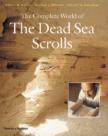Unearthing a Fascinating History
The Dead Sea scrolls have fascinated the general public for over 50 years. Indeed, 10 years ago they were front-page news, with wild claims about their contents and charges about coverups and conspiracies. What has happened since, and what can we expect in the future? These two fine books can help toward answering such questions.
The Dead Sea scrolls are now almost completely published. The first “battle of the scrolls,” fought in the late 1940’s and 1950’s, concerned their antiquity and authenticity. The second battle, which dealt with their complete publication, took place in the late 1980’s and 1990’s. The third battle, now looming, pertains to their proper interpretation and significance.
In their lavishly illustrated Complete World of the Dead Sea Scrolls, Philip Davies (professor of biblical studies at the University of Sheffield), George Brooke (professor of theology and religion at the University of Manchester) and Phillip Callaway (lecturer and scholar of Dead Sea Scroll studies) provide a handy guide to the various battles and point out the issues that will be debated in the future.
After describing the discovery of the scrolls, the authors present the historical backdrop against which the scrolls were written, offer general comments about the scrolls and provide analyses of the major texts, discuss recent archaeological work at Qumran and the nature of Qumran settlement and examine the relevance of the scrolls for understanding Judaism and early Christianity.
While full of information about the Dead Sea scrolls and Second Temple Judaism, this volume is also both attractive and readable. If you want to see what the Dead Sea scrolls look like and what Qumran looks like, you will find here many photographs of the manuscripts along with architectural plans, sketches, famous artworks, tables, boxes and so on. From their previous publications it is clear that the three authors, while all specialists in the study of the Dead Sea scrolls, disagree on many issues. But they have turned their differences into a virtue in that they are careful to present all sides of controversial issues. In this way they help to move forward the task of better understanding the Qumran texts and their relationship to the site at which they were found over 50 years ago.
Two basic questions regarding Qumran concern the purpose of the main site and its relationship to the scrolls discovered in the caves surrounding it. In the early 1950’s Roland de Vaux, O.P., excavated Khirbet Qumran and concluded that it was used as a community center for a Jewish religious movement (most likely Essenes) from the second century B.C. to the first century A.D. In recent years, however, the main buildings at Qumran have been interpreted in other ways (villa, manor house, fort or commercial warehouse), and the connection between the site and the scrolls has been questioned.
In The Archaeology of Qumran and the Dead Sea Scrolls, Jodi Magness, who taught for many years at Tufts University and is now at the University of North Carolina at Chapel Hill, upholds de Vaux’s basic interpretation of Qumran and establishes the link between the main site and the caves by appealing to the unusual style of pottery found in both places, while showing the weaknesses of other explanations. She provides basic information about the site and combines the results of the archaeological excavations with literary analysis and historical sensitivity. She has produced a scholarly and scientific book that is also readily accessible to a general audience.
Instead of presenting a dry report on the excavations, Magness brings together the data and the various methodological perspectives to offer a fascinating glimpse of Jewish life in the Qumran community: how and what they ate, how and why they bathed, what they wore, how they went to the toilet, how they buried their dead and whether there were women members (not many). She also places the Qumran excavations in the context of recent developments in late Second Temple archaeology, and so on some points (e.g., ritual baths) she is able to be more definitive than de Vaux was. Moreover, she modifies de Vaux’s history of the site, and so provides a more convincing story of its occupation between the first century B.C. and A.D. 68. And she shows how the archaeological data contribute to understanding the ideology of the Qumran group. These people emerge as Jewish priestly apocalyptists who created their community as a “virtual temple” and opposed trends toward Hellenization.
These are two excellent and timely studies in an area of ongoing interest to specialists and general readers.
This article also appeared in print, under the headline “Unearthing a Fascinating History,” in the September 23, 2002, issue.








